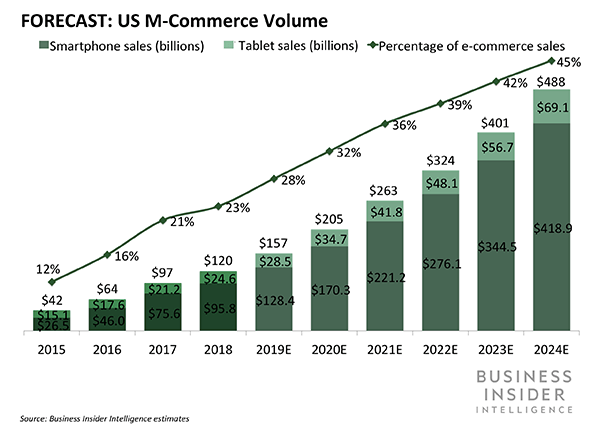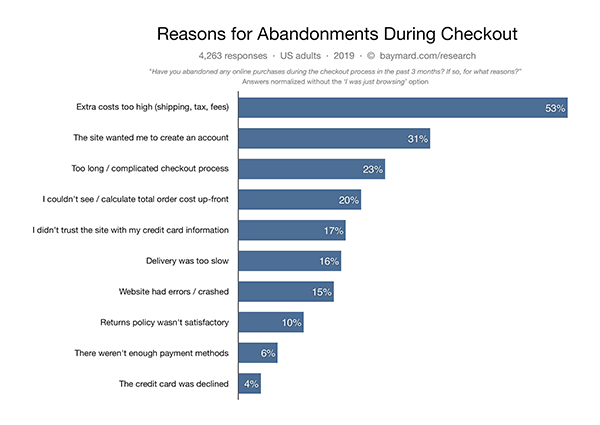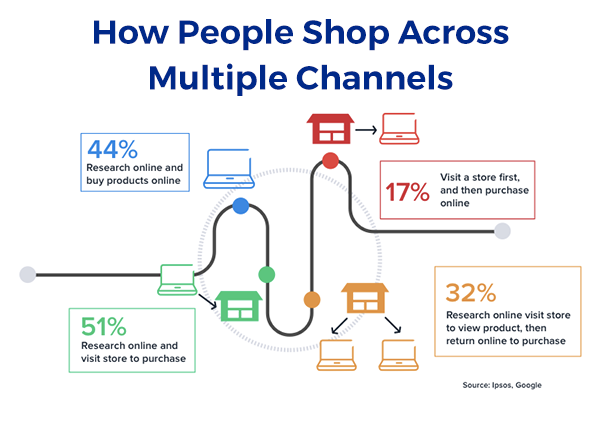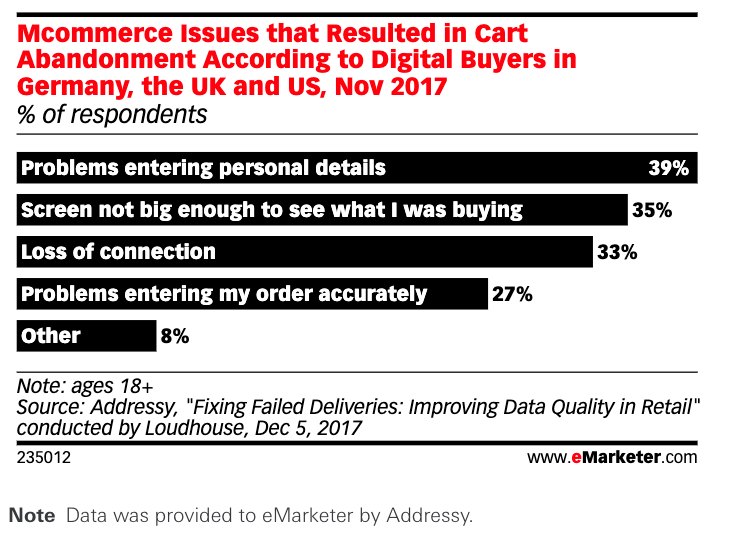In this article, we will uncover 6 ways retailers can improve their eCommerce customer experience.
To succeed in 2020 and beyond, eCommerce retailers must do everything in their power to provide customers with a great user experience.
More specifically, eCommerce retailers have to provide apps or websites that offer the value, functions, and consistency that consumers crave. This includes the following:
- A mobile-first strategy
- Personalization
- Data protection and data privacy
- Adoption of new technology
- An omnichannel customer experience
- An easy and clear checkout
6 Keys to eCommerce Customer Experiences
1) A Mobile-First Strategy
Providing an eCommerce website that is adapted for smartphones is no longer an option, it is a requirement. For several years, the share of consumers that shop online using a smartphone continues to rise.

Thanks to the growing number of digital channels as well as the growth of smartphones, increase in broadband connectivity, and social adoption of shopping via smartphones, more consumers are connecting with brands and retailers across multiple channels including their apps and websites.
To put it simply, it is crucial to provide a great mobile experience due to the number of customers who shop and research products and brands via their mobile. At the same time, providing a poor mobile experience can lead to a loss of customers and revenue. A recent study concluded that 50% of customers will stop visiting a website that offers a poor mobile experience, even if they have a favorable opinion of the business or brand.
Other research highlights the importance of the mobile customer experience. According to a study conducted by Magento, 22% of online shoppers are sensitive the proper function of a website or app. Amongst online shoppers between 25 and 34 years old, 42% view the mobile customer experience as being critical.
Overall, according to predictions by CBRE, smartphones will account for more than 50% of eCommerce sales globally by 2021.
Progressive Web Apps
The importance of having an eCommerce website that is adapted for smartphones is giving rise to Progressive Web Apps (PWA).
A PWA helps retailers overcome a significant challenge: providing a clean, consistent user experience via their website and mobile apps. Furthermore, PWA's enable retailers to offer customers an app-like experience without having to invest the time or resources required to develop and maintain a mobile eCommerce app.
Retailers that are using and benefiting from PWA's include:
Lancôme
- 53% increase in session length
- 10% decrease in bounce rate amongst iPhone users
Alibaba
- 76% increase in conversion rates
Jumia
- 8% decrease in cart abandonment rate
Interested in learning more about Progressive Web Apps? Please do not hesitate to download our infographic on the State of PWA's.
2) Personalization
People like to receive offers and content that are actually relevant to their interests. So it should come as no surprise that personalization is a key component in the recipe for eCommerce success.
A lack of personalization can be quite expensive for retailers. According to Accenture, in 2016, 41% of consumers switched companies due to a lack of trust and poor personalization resulting in a loss of more than $750 billion for these businesses.
On the flipside, getting personalization correct, according to Gartner, can help business increase their profits by up to 15%. Moreover, research shows that consumers spend 48% more as a result of strong personalization.
A company that is succeeding in this endeavor is Amazon. According to the consulting group McKinsey & Company, about 35% of Amazon’s purchases come from recommendations customers receive from the retail giant.
As more retailers move to improve their ability to provide a personalized customer experience, the competition to retain and attract new customers will grow more fierce.
3) Data Protection and Data Privacy
Protecting consumers personal data is one of the most important requirements for eCommerce retailers.
Today, the vast majority of online shoppers are concerned about their personal data, which can often include sensitive information such as their address, phone number, credit card information, and more.
While studies point to the fact that consumers are willing to exchange more of thier personal information for greater personalized recommendations and offers, concerns regarding the security of their information remain. In fact, a KPMG survey highlighted that 55% of online consumers have declined to make a purchase online due to concerns over data privacy.
Another study by Baymer also reveals that nearly 1 in 5 online consumers have abandoned an online purchase from a website they did not trust with their credit card information.
 In addition, recent legislation is requiring eCommerce retailers to do more to protect the consumers' personal data. This includes the European Union’s General Data Protection Regulation (GDPR) and California’s Consumer Privacy Act (CCPA) which can levy fines against companies that violate the law.
In addition, recent legislation is requiring eCommerce retailers to do more to protect the consumers' personal data. This includes the European Union’s General Data Protection Regulation (GDPR) and California’s Consumer Privacy Act (CCPA) which can levy fines against companies that violate the law.
To quel consumers' concerns, eCommerce retailers can take various actions such as only collecting the data that is absolutely necessary and being transparent with consumers regarding how the collected data will be used.
In addition, strengthening one’s cybersecurity is an important way to get to consumers to trust your eCommerce platform. Marketing the security of an eCommerce site, for example, via trustmarks is also good way to build consumer confidence.
In general, offering a secure website or app that respects the privacy concerns of online consumers is a great way to ensure success for years to come.
4) Adoption of New Technology
A key to improving the customer experience within eCommerce players is to adopt new technology that is poised to transform online shopping. Many marketers believe voice and image searches will play significant roles in the future.
This speculation is supported by the fact that nearly 75% of people would rather use voice functions to search for product. At the same time, marketers expect the number of smart-speaker users who search by voice to rise to 50% in the near future.
Consumers between 18-34 years old are too showing a growing embrace of visual search and image recognition technology to discover new products and brands. Gartner highlights the potential of this technology. By 2021, Gartner estimates that eCommerce revenue will increase up to 30% for retailers who are early to integrate image search and image recognition technology into their apps and websites.
Brands that have already implemented this technology into their apps or websites include Pinterest, Target, and ASOS.

Given the proliferation of vocal assistants like Amazon’s Alexa as well as the fact that people process visual information faster than text, we can expect to see voice and visual searches become more important.
5) An Omnichannel Customer Experience
Online shoppers rarely stick to one channel. In fact, the majority of shoppers use multiple channels during the customer journey.
To succeed, it is important for eCommerce retailers to develop an omnichannel customer experience that give customers a seamless and consistent experience across all channels.
 Concretely, an omnichannel customer experience allows shoppers to start and complete purchases across different digital channels without having to restart the process. Omnichannel retail even allows customers to view in-store availability of a product, and purchase or reserve the item and pick it up from a nearby store location.
Concretely, an omnichannel customer experience allows shoppers to start and complete purchases across different digital channels without having to restart the process. Omnichannel retail even allows customers to view in-store availability of a product, and purchase or reserve the item and pick it up from a nearby store location.
It would be a mistake to ignore the fact that the omnichannel customer experience is being driven by customer expectations. According to SAP, 71% of consumers expect to be able to see in-store inventory information from an eCommerce site or app. Moreover, 50% consumers expect retailers to offer “buy online, pick up in-store” services as well as consistent product choices and promotions across multiple channels.
To compete with the competition and meet consumer expectations, updating eCommerce apps and websites to provide an omnichannel customer experience will be crucial.
6) A Quick and Easy Checkout
Last but certainly not least, the checkout process is vital to the overall success of every eCommerce platform. Online shoppers are particularly sensitive to the checkout process, which can make or break a sale.
Research conducted by Magento shows that 25% of online consumers are sensitive to the speed at which the checkout process can be completed. Furthermore, online consumers expect a clear and fluid checkout process lasting no more than 2 minutes.
Overall, retailers must take steps to provide consumers with a checkout process that is fluid, clear, and easy to use. This is easier said than done given the various issues that often vex consumers such as requiring consumers to make an account, complicated and confusing checkout process, a lack of prefered payment options, and technical issues such as bugs that disrupt the checkout process.

Amongst mobile shoppers, problems associated with the design and functioning of eCommerce sites were a leading cause of cart abandonment. A study by eMarketer reveals that nearly 40% of shoppers abandoned their cart due to problems entering personal information. Another 35% cited problems with the display or layout of the site on their mobile as the reason for their cart abandonment.
To improve the checkout process, eCommerce retailers should ensure the checkout process is optimized for mobile shoppers. Furthermore, it is important to ensure the process is fluid by eliminating an unnecessary questions, forms, etc. Designing the each page with a consistent layout is also key to creating an easy to use checkout.
QA Testing eCommerce Sites and Apps
When it comes eCommerce websites and apps, the role of Quality Assurance (QA) testing cannot be overlooked.
QA testing enables brands and retailers to not only assess the functional readiness of an eCommerce site or app, but the user experience as well. Together, both of these aspects play a significant role in shaping the customer experience and business' bottomline.
To offer the best eCommerce platform possible, it is essential to test early and often, especially following updates that add new functions or redesigns in an effort to enhance the customer experience.
To learn more about QA testing eCommerce sites, please do not hesitate to download our white paper below.
.png?width=1200&name=Banner-ecommerce-EN%20(1).png)



 In addition, recent legislation is requiring eCommerce retailers to do more to protect the consumers' personal data. This includes the European Union’s General Data Protection Regulation (GDPR) and California’s Consumer Privacy Act (CCPA) which can levy fines against companies that violate the law.
In addition, recent legislation is requiring eCommerce retailers to do more to protect the consumers' personal data. This includes the European Union’s General Data Protection Regulation (GDPR) and California’s Consumer Privacy Act (CCPA) which can levy fines against companies that violate the law.
 Concretely, an omnichannel customer experience allows shoppers to start and complete purchases across different digital channels without having to restart the process. Omnichannel retail even allows customers to view in-store availability of a product, and purchase or reserve the item and pick it up from a nearby store location.
Concretely, an omnichannel customer experience allows shoppers to start and complete purchases across different digital channels without having to restart the process. Omnichannel retail even allows customers to view in-store availability of a product, and purchase or reserve the item and pick it up from a nearby store location.
.png?width=1200&name=Banner-ecommerce-EN%20(1).png)

